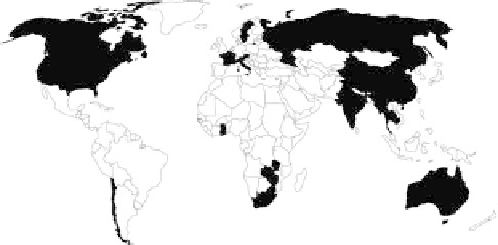Geography Reference
In-Depth Information
Table 11.1. Summary of the case studies
Case study: section
Country
Climate
Nature of study
Method
11.2
India
Semi-arid
Annual runoff
Index
11.3
China
Semi-humid
Annual runoff
Spatial proximity
11.4
Russia
Continental/Cold
Annual runoff
Index
11.5
Canada
Continental/Cold
Inter-annual runoff
Process-based
11.6
South Africa and Lesotho
Semi-humid
Seasonal runoff
Process-based
11.7
North-east USA
Continental/Cold
Hydrographs
Regression/Geostatistics
11.8
Canada
Continental/Cold
Hydrographs
Process-based/Similarity
11.9
Italy
Semi-humid
FDC
Regression/Index
11.10
Austria
Continental/Cold
Floods
Geostatistics
11.11
Australia
Humid/Tropical/Arid
Floods
Regression
11.12
Chile
Humid
Flow path
Process-based/Regression
11.13
France
Semi-arid
Annual runoff
Short records
11.14
Zambia
Humid/Tropical
Hydrographs
Process-based
11.15
Ghana
Tropical/Semi-arid
Hydrographs
Process-based
11.16
South-west USA
Semi-arid
Hydrographs
Process-based
11.17
Zimbabwe
Sub-tropical
Annual runoff/Seasonal
runoff/FDC/Low flows
Process-based/Regression
11.18
Australia
Humid/Tropical/Arid
Hydrographs
Process-based/Similarity
11.19
South-east Asia
Cold/Tropical
Hydrographs
Process-based
11.20
Sweden
Continental/Cold
Hydrographs
Process-based/Similarity
studies aimed at improving estimates of design floods in
ungauged basins.
The study by Blume (Chile) focuses on understanding
flow paths and storage characteristics in a steep, represen-
tative catchment in the Andes mountains, using both
experimental work and detailed process modelling. Two
studies in Africa by Winsemius and Savenije (Zambia) and
Liebe et al. (Ghana) address critical issues related to model
development and validation in data-poor situations, in each
case coming up with truly innovative methods. The case
study by Crabit et al. (France) presents a novel framework
to define hydrological signatures of ephemeral streams on
small poorly gauged agricultural catchments, on the basis
of new soft monitoring techniques for rainfall and runoff
measurements. The study by Kennedy et al. (USA) pre-
sents work on enhancements to a process model in the arid
south-west of the USA to address issues related to urban
development. Mazvimavi (Zimbabwe) presents a compre-
hensive study of runoff regionalisation using both statis-
tical and process-based methods, reflecting the themes of
the entire topic.
The case studies by Viney (Australia), Samuel et al.
(Canada), Takeuchi et al. (South-East Asia, Mekong
Basin) and Arheimer and Lindström (Sweden) involve
application of continuous rainfall
Figure 11.1. World map with the countries present in the case
studies.
this topic. These include mapping the patterns of annual
runoff in major catchments in India (Biggs), China (Jia)
and Russia (Korytny et al.), and dealing with parameter
uncertainty in seasonal runoff predictions in South Africa
using a monthly model (Hughes). Indeed, Biggs (India)
overcame severe data limitations by invoking sound hydro-
logical insights in the form of the Budyko curve. Pomeroy
et al. (Canada) present the application of a distributed
physically based cold regions hydrological model to pre-
dict inter-annual variability of annual runoff.
Archfield (USA) and Castellarin (Italy) present compre-
hensive studies involving estimation of key runoff indica-
tors based on regionalisation of flow duration curves to
ungauged sites. Similarly, Merz et al. (Austria) and Rah-
man et al. (Australia) present comprehensive national
runoff models over large
catchments or regions involving a large number of
ungauged sites. Viney uses model averaging to obtain
improved performance. Samuel et al. adopt strategies to
improve model structures and to regionalise parameter
-




Search WWH ::

Custom Search